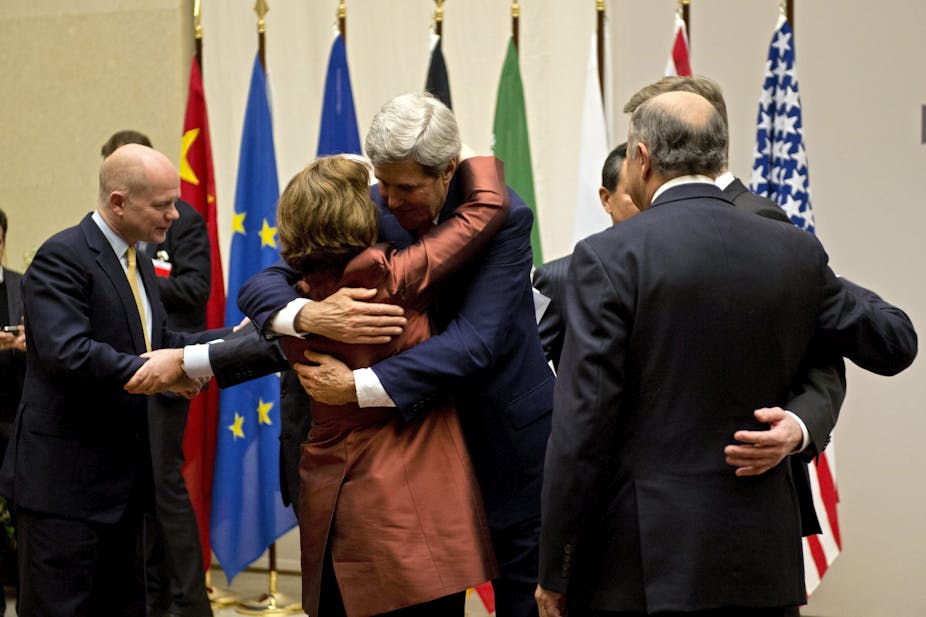Elation and relief were palpable as weary diplomats from Iran and the P5+1 states emerged from a Geneva conference room on Sunday with a deal to curb Iran’s nuclear program.
The six month Iranian uranium enrichment freeze represents another step in a trend of détente between Tehran and the west since the election of Iranian president Hassan Rouhani and his policy of rapprochement with western powers, in particular the United States.
But while the personalities of individual diplomats involved in the negotiation process are crucial, the capacity to engage in such negotiations remains predicated on the international and domestic structural issues affecting Iran itself.
The spectre of Khatami
Given the nature of the suspension deal, veteran Iran observers will naturally recall a similar effort made by the Khatami administration in 2004. Here, Iran suspended its uranium enrichment for several months as an olive branch towards the US, following several other failed efforts.
The US, emboldened by its apparent successes in Afghanistan and Iraq and driven by a radical new internationalist ideology, viewed such efforts as a mere ploy of a state it had already allotted to the “Axis of Evil”.
Although the nature of this case study does provide a negative precedent, the conditions surrounding Sunday’s negotiations are in stark contrast to 2004. Where US rhetoric then remained aloofly hostile to Khatami’s détente, nearly a decade on, it appears to be emphatically supportive of Rouhani’s own drive towards engagement.
The fact that the Geneva deal elicited concessions on both sides also separates it from previous deals. For its efforts, some of the more draconian sanctions levelled against Iran have been eased, allowing for increased – if limited – exports and engagement with international markets, as well as the unfreezing of around US$8 billion in frozen Iranian assets.
If nothing else, the deal has shown that direct and ongoing diplomacy between the US and Iran is viable in 2013 - a marked shift from the past 30 years.
The security environment
The transformation in US regional security posturing around the Middle East and Central Asia was a key element in the success of the Geneva talks.
As I’ve previously argued, the main factor driving Iran’s nuclear weapon aspirations has always been the United States, not Israel. Although Israel may be able to threaten Iran with limited strikes, it has always lacked the capacity to affect regime change.
The US, by contrast, has twice shown both the ability and the willingness to topple governments on the Iranian periphery (in Iraq and Afghanistan) within the past decade. The Iranian drive for nuclear capabilities (and ambiguities) has always been an insurance policy against such eventualities.
But with the US out of Iraq and reducing its footprint in Afghanistan under a different administration, such a threat is rapidly diminishing. Empirical evidence of this shift in security priorities has been found in the ongoing US reluctance to engage in any sort of major action inside Syria. Obama’s adoption of a more traditional, “realist” posture on US foreign policy appears to have allayed many Iranian concerns generated by the chaotic neo-conservative years of the Bush administration.
American regional disengagement and predictability means that Iran can be more confident on the power of its conventional capabilities to deter its main regional threats: Israel and Saudi Arabia. New expansions in this area appear to already be under way, with Russia recently declaring they will supply Iran with “information, air defence techniques, electronic and radar as well as missile systems”.
This commitment represents an about-face to the 2010 low point of Iranian-Russo relations, where Moscow abruptly cancelled several strategically critical air defence contracts it had signed with Iran.
Internal pressures
While the change in regional security conditions around Iran has been critical for diplomatic engagement, domestic conditions within the state have also generated major pressures for similar efforts.

Thanks to sanctions, Iranian oil exports have fallen by two-thirds since 2011, causing the state’s currency to suffer a similar level of devaluation. On the street, the cost of living has soared due to inflation. Where a kilo of rice was just three Australian cents in 2007, today it costs A$2.50.
Iranian leaders are likely to be only too aware of the significance of the cost of foodstuffs and other basic amenities in the recent Arab Spring protests, as well as the latent potential of their own population to mobilise for mass protest in response to perceived deprivations.
Thirty years of sanctions have taken their toll on the Iranian people. Although the state has been able to stumble on as the symbol of “Islamic Revolution”, the benefits of such a status have become increasingly scarce. Meanwhile, the costs loom, with an economy that shrunk 5.4% in 2012.
Small increments
With diminishing existential security threats and a sinking economy, structurally there appears to be little advantage to Iranian nuclear weaponisation. Iran has little desire to become a basket case state like North Korea – armed to the teeth with a black hole economy.
Despite this desire, however, the Geneva talks and concessions are far from the cure-all of Iranian-Western relations.
US$8 billion may seem like a lot, but it is a relatively small amount in an economy that last year produced a GDP of US$548 billion. Six months of non-enrichment is a good start, but similar efforts have failed before due to a lack of will and effective communications.
The gains made on Sunday are important but limited. To truly be considered a success they must be an incremental component within a broader strategy of Western-Iranian re-engagement, aiming to address the underlying diplomatic, economic and cultural grievances of the past three decades and beyond.

